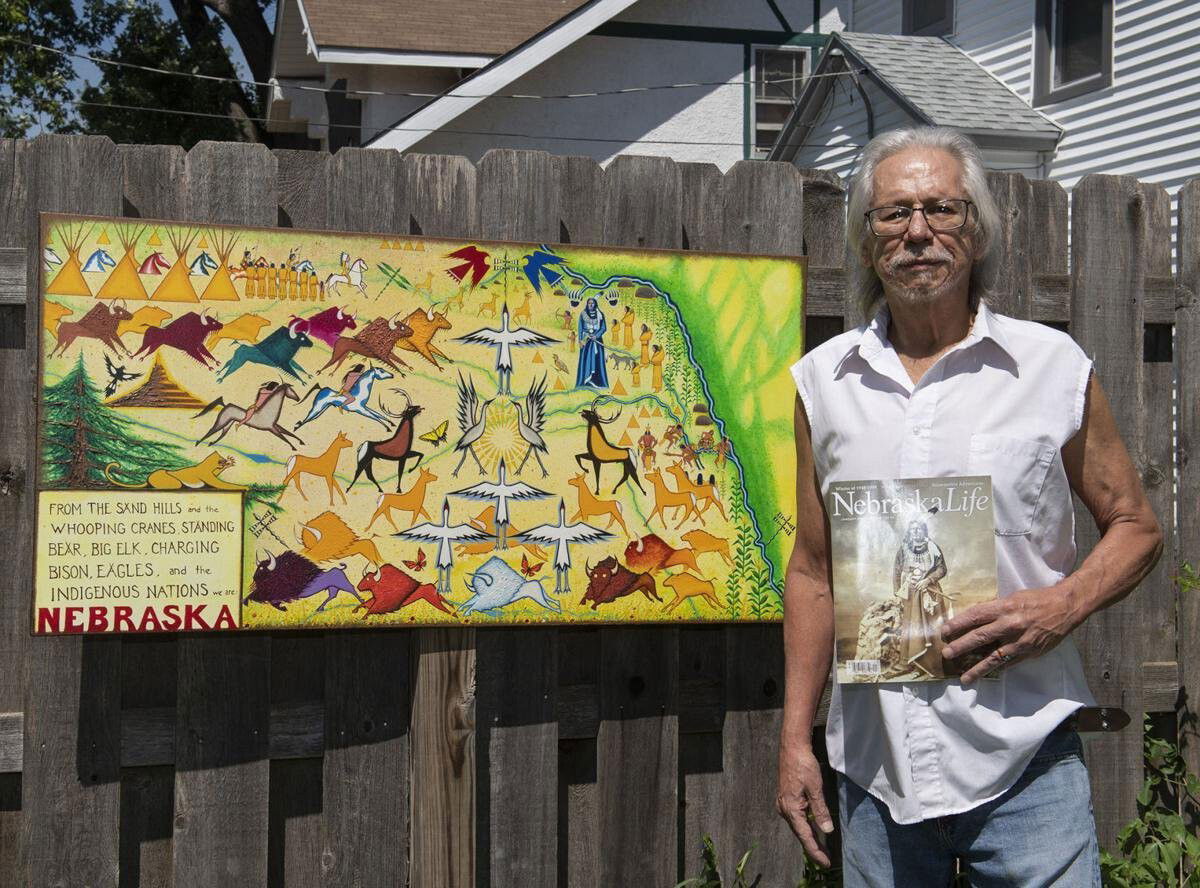First People license plate getting on more vehicles

Omaha artist Donel Keeler poses with his artwork in 2019. Keeler created Nebraska's First People license plate.
By Cindy Lange-Kubick
Click here for updates on this story
LINCOLN, Nebraska (Lincoln Journal Star) — Ross Smith had a mission and he quietly set out to fulfill it.
He picked up his phone and knocked on the doors of politicians, hoping to earn their support for his idea: A license plate honoring Natives.
Smith wasn’t Native, but he felt a calling to help.
In the middle of his campaign, Smith was diagnosed with pancreatic cancer and, after he was gone, his good friend Gary Hughes helped carry the torch.
Smith was 78 when he died Dec. 24, 2016, six months before LB 263 passed.
But he was there in spirit that day in the Capitol Rotunda as they unveiled the proposed plates, his family says.
And in the more than three years since, his legacy has remained bolted to the bumpers of their cars.
4RO5S
4DAD
4POPS
SNAG, for a son-in-law who loves to fish.
GLTTR, for a granddaughter who likes to sparkle.
LOTO, for a grandson whose favorite place is Lake of the Ozarks.
GVBCK, for his youngest daughter, Shawnie Motschenbacher, her way of honoring his community-minded nature.
Thirteen members of the Smith family have those First People license plates on their vehicles, said his oldest daughter Shereen Mills, who picked 4DAD for her Honda Pilot.
Today, those First Person plates are on the bumpers of more than 1,700 Nebraska drivers.
Willa Smith remembers her husband calling the Department of Motor Vehicles in those early days of his campaign — as far back as 2012 — telling the woman who answered the phone his dream.
The DMV employee kept in touch and, later, she told Smith’s widow that after that first phone call, she’d turned to a coworker: This man really wants this done, but I don’t think it will ever happen.
And then it did.
Ross Smith went further, insisting that $30 of the $40 fee for personalized numeric plates would go to the Chief Standing Bear Scholarship fund and that every penny of the $5 fee for random numeral plates would, too.
The story didn’t end with him.
There was the artist whose drawing made the vision come alive.
And the Nebraska Commission on Indian Affairs that lent its support.
And all the Nebraskans who purchased those plates, allowing the scholarship fund to grow and grow, until enough money was gathered this spring to grant the first four of many scholarships to come for Nebraska’s deserving Native students.
Her dad wouldn’t want attention focused on him, Mills said last week.
“He would want others to realize the plight and history of Native Americans.”
Her dad wouldn’t want attention focused on him, Mills said last week.
“He would want others to realize the plight and history of Native Americans.”
* * *
Donel Keeler died in the spring of 2020.
The 68-year-old artist lived in Omaha, a member of the Crow Creek Dakota and Northern Ponca tribes who had wrestled Stage 4 liver cancer for more than five years.
His son Jesse Keeler moved home from Colorado to care for his dad, a self-taught artist whose work often featured a modernized style of ledger art.
Back in the mid-90s, father and son spent a summer on the road.
“We went to 14 different states on the Pow Wow Highway,” Jesse Keeler said. “He painted kids’ faces, hustled selling his artwork.”
His father loved to see Native people prosper, he said. And he knew the importance of supporting Native youth.
The elder Keeler donated money and artwork to causes he believed in and was proud of seeing his artwork on the specialty plates.
So is his son.
The younger Keeler wears his father’s art on the bumper of his car. A four-letter Native colloquialism: ENIT.
He loves seeing the First People plates as he drives around Omaha and beyond.
“Seeing his plates every morning on my way to work is like him saying good morning and throughout the day it’s his way of saying hello.”
The feeling of pride is huge, he says.
“The Buffalo roams again.”
* * *
The Native high school students included essays in their applications for the Chief Standing Bear scholarships.
They talked about their lives and their dreams for the future. What they planned to study and where.
A committee reviewed their words and picked five students to receive $5,000 scholarships; four of them funded from sales of the plates.
“One of the greatest barriers to higher education for Native students is financial constraints,” said Alexander Mallory, chair of the scholarship selection committee.
He called it a privilege to help administer a scholarship that supports those personal and professional dreams.
“I am excited to watch them soar and make an impact in Indian Country and beyond.”
And the opportunity will continue.
They expect to continue to receive at least $20,000 a year flowing into the Chief Standing Bear Scholarship Fund from plate revenue and new plate purchases, said Judi gaiashkibos, executive director of the Nebraska Commission on Indian Affairs.
“The sales of the plate surpassed our wildest dreams,” gaiashkibos said. “We are thankful for all of the Nebraskans, current and future, that support this license plate that establishes scholarships for Native American students.”
The first students to receive Chief Standing Bear Scholarships are equally thankful.
“I’ve been inspired by the ideals of Chief Standing Bear,” wrote Maddox Smith of DeWitt who hopes to teach on a Nebraska reservation or Native village in Alaska.
“And I feel so honored to have received such a generous gift.”
Please note: This content carries a strict local market embargo. If you share the same market as the contributor of this article, you may not use it on any platform.